#493rd Fighter Squadron
Photo

Parked in a line on a flight line are, from front to back, a 493rd Tactical Fighter Squadron F-111F, an 81st Tactical Fighter Wing A-10A Thunderbolt II, a 525th Tactical Fighter Squadron F-15 Eagle, an 81st Tactical Fighter Squadron F-4E Phantom II, 496th Tactical Fighter Squadron F-16 Fighting Falcon and an F-5E Tiger II aircraft. 1987.
#F-111#A-10#F-15#F-4#F-16#F-5E#F-4E#A-10A#F-111F#Aardvark#Thunderbolt II#Warthog#Eagle#Phantom II#Fighting Falcon#Tiger II
100 notes
·
View notes
Text

A D not an E. McDonnell Douglas F-15D Eagle assigned to the 493rd Fighter Squadron. (U.S. Air Force/TSgt. Eric Burks)
@kadonkey via X
20 notes
·
View notes
Video
New Reaper by Treflyn Lloyd-Roberts
Via Flickr:
USAF F-35 19-5493 speeds through the Lake District on a low level training sortie. This jet is marked up for RAF Lakenheath's 493rd Fighter Squadron "Grim Reapers", who had only just retired their F-15Cs and Ds the previous month. Aircraft: USAF Lockheed Martin F-35A Lightning II AF 19-5493/LN from 48th Fighter Wing based at RAF Lakenheath, Suffolk. Location: Raven Crag, Thirlmere, Lake District, Cumbria.
#USAF#F-35#19-5493#speed#through#Lake#District#LFA17#low#flying#level#training#sortie#jet#mark#up#RAF#Lakenheath#493rd#Fighter#Squadron#Grim#Reapers#just#retire#F-15C#F-15#F-15D#previous#month
481 notes
·
View notes
Video
‘The King’ by Chris
Via Flickr:
493rd FS F-15c Heritage Jet. “The King”
#48th Fighter Wing#493rd Fighter Squadron#493rd FS#F-15C#USAF Lakenheath#Heritage Jet#Canon.#Canon L-Lens
27 notes
·
View notes
Text
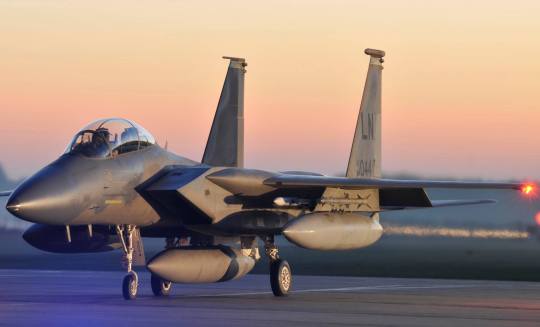
ROYAL AIR FORCE LAKENHEATH, England - An F-15D Eagle of the 493rd Fighter Squadron undergoes final preparations prior to take-off from RAF Lakenheath on April 8, 2011. The 493rd FS deployed Airmen and assets to an undisclosed location in Southwest Asia. (U.S. Air Force photo/Senior Airman Tiffany M. Deuel)
41 notes
·
View notes
Video
F-15C flyby. Duxford, 08-9-2012 by Alan Wilson
Via Flickr:
Four McDonnell Douglas F-15C Eagles from the 493rd Fighter Squadron, part of the 48th Fighter Wing of the United States Air Force based at RAF Lakenheath. The aircraft are:- 84-0001, an F-15C-37-MC with the c/n 0908 and l/n C304, 84-0010, an F-15C-37-MC with the c/n 0919 and l/n C313, 86-0163, an F-15C-42-MC with the c/n 1010 and l/n C391 86-0164, an F-15C-42-MC with the c/n 1011 and l/n C392 Seen during a flyby at the Imperial War Museum’s 2012 Autumn Airshow. Duxford Airfield, Cambridgeshire, UK 8th September 2012
9 notes
·
View notes
Text
Operation El Dorado Canyon: Libya Under Air Attack in 1986
In early 1986, an U.S. Air Force F-111F Aardvark pilot and squadron commander knew that something big was coming and that it involved an attack on Moammar Gaddafi’s Libya.
“We had been planning for about four months,” said the lieutenant colonel, “Everybody knew this was coming.” At his request, his name does not appear here.
Plans and rehearsals for a strike on Libya that were already under way intensified after the April 5, 1986, bombing of the La Belle discotheque in West Berlin that killed a Turkish woman and two American sergeants, Kenneth T. Ford and James E. Goins, and injured 230, including 50 U.S. military members. U.S. intelligence linked the bombing to the Libya-backed Abu Nidal Organization.
A skit on the British television satire “Spitting Image” showed President Ronald Reagan playing in his bathtub with a toy F-111F. Plans and rehearsals for a strike on Libya that were already under way intensified after the April 5, 1986, bombing of the La Belle discotheque in West Berlin that killed a Turkish woman and two American sergeants, Kenneth T. Ford and James E. Goins, and injured 230, including 50 U.S. military members. U.S. intelligence linked the bombing to the Libya-backed Abu Nidal Organization.
Mission planners hoped the French government would give permission to overfly its territory.
Said the pilot: “The White House threw curveballs to the mission planners. The original plan called for a raid by 18 F-111Fs if France gave us overflight clearance or just six aircraft if we had to take the longer journey around the European continent. After France denied overflight permission, orders from Washington kept the raid size at 18 aircraft, introducing an exponential increase in the needed size of the tanker force.”
One target that was put on the list, removed, and restored was the Al Azziziyah Barracks, called the “Libyan White House,” prompting some U.S. flyers to believe they were being tasked to kill Gaddafi.
Plans to use the supersecret F-117 stealth aircraft, then part of a “black” program in the Nevada desert, were scrubbed. Following carrier- based air strikes on Libyan naval targets in March and early April, the brunt of the mission – called Operation El Dorado Canyon – fell on the 48th Tactical Fighter Wing, the “Liberty Wing,” at RAF Lakenheath, England. The pilot interviewed for this story was commander of the wing’s 493rd Tactical Fighter Squadron.
OPERATION EL DORADO CANYON
On the night of April 14-15, 1986, the Air Force undertook its first combat since Vietnam. Twenty-four F-111F Aardvarks (including six spares) launched from Lakenheath, supported by five EF-111A Raven electronic jamming planes from Upper Heyford, nineteen KC-10A Extenders and 10 KC-135 Stratotankers. The strike leader – the pilot quoted here – flew an F-111F with the callsign Remit 31.
“We were in the briefing room. I still didn’t think we were really going to do this thing. I was thinking, ‘This is going a little farther than our last exercise.’ Then I looked up and saw the chief of staff of the U.S. Air Force, Gen. Charles Gabriel. The wing commander, Col. Sam Westbrook, introduced Gabriel and he started talking. That’s when I knew, ‘This is a “real-world’ mission and they’re going to be shooting at us.”
The F-111F was formidable. With a bulge in its belly caused by its all-weather AN/AVQ-26 Pave Tack infrared targeting designator/reader, it was able to track and designate ground targets for laser, infrared and electro-optical bombs. Two 25,100-pound thrust Pratt & Whitney TF30-P-100 turbofan engines provided power. A variable-geometry or “swing” wing permitted better handling at low speeds in the airfield pattern (when swept forward) and very high speed (when swept back). The crew sat side-by-side, the pilot on the left. Beside him was the weapons systems officer (WSO), who was sometimes called a YOT for “you over there.”
Said the Remit 31 pilot:
“We were in the briefing room. I still didn’t think we were really going to do this thing. I was thinking, ‘This is going a little farther than our last exercise.’ Then I looked up and saw the chief of staff of the U.S. Air Force, Gen. Charles Gabriel. The wing commander, Col. Sam Westbrook, introduced Gabriel and he started talking. That’s when I knew, ‘This is a “real-world’ mission and they’re going to be shooting at us.
“After the briefing, I talked to Gabriel. I didn’t think Gabriel knew me from Adam, but he looked at me, uttered my first name, and asked: ‘Do we know if Col. Gaddafi is going to be asleep in his house tonight?’ I said, ‘Sir, I don’t know, but I promise you he won’t be able to sleep in it tomorrow night.’ No one ever said that our purpose was to kill Gaddafi, but we thought they were telling as much without actually using the words.” 48th TFW commander Westbrook went aboard a KC-10A Extender tanker that would serve as an airborne command post and the Remit 31 crew climbed into their Aardvark.
“If I close my eyes, I can still remember what it smelled like in the cockpit,” the pilot said. “When you go out to fly, you have a card that goes on your clipboard. There, you write down all the pertinent information about that flight – the weather briefing, the callsigns, tail number, frequencies. I wrote the code words we would use. We were to transmit the words Frosty Freezer if our mission failed.”
INTO THE MISSION
In radio silence, in the early evening of April 14, the El Dorado Canyon strike force took to the air. F-111Fs that typically flew a combat mission lasting three hours would tonight be in the air for 14 hours. From Westbrook on down, no one was completely certain that the Aardvark airframe could tolerate that much stress. As for the men in the cockpits, most of the F-111F crews had never seen combat, some had never refueled from a KC-10A and none had ever done so at night under radio silence.
Once the F-111Fs reached the Atlantic as darkness gathered around them, crews conducted a short refueling to confirm that both tanker and fighter refueling systems were performing properly. Spares replaced two of the primary aircraft while the remaining four spares returned to Lakenheath. The trio of six-plane formations (Remit, Elton, and Karma flights) stayed in company with “mother ship” KC-10As for the circuitous journey around Europe to the Mediterranean.
Each aircraft in Remit and Elton flights carried four GBU-10 2,000-pound laser guided bombs, to attack leadership targets. Karma flight carried nine Mark 82 Snakeye 500-pounders for use against airfield targets.
After the raid, a Pave Tack video showed Remit 31’s four bombs landing short of Gaddafi’s house (the Azziziyah Barracks) but allegedly killing “Hanna,” the Libyan leader’s infant daughter, and injuring others.
Refueling often, the F-111Fs swarmed down on Tripoli shortly after midnight. Flying inbound off the Libyan coast at low level, the F-111F using the callsign Karma 52 (serial no. 70-2389) crashed in the Mediterranean. Remit 31’s pilot saw it happen. “It was a smear across the water. It reminded me of having seen napalm in Vietnam.”
No one knows whether Karma 52 had a mechanical malfunction, whether pilot Maj. Fernando L. Ribas-Dominicci flew into the water, or whether Gaddafi’s air defenses scored a hit. Ribas-Dominicci and his WSO Capt. Paul F. Lorence lost their lives. The rest of the strike force went “downtown,” arriving over Tripoli at 2:00 a.m. local time.
The pilot of Remit 33 (serial no. 74-0178) found himself over Tripoli with an unexpected problem. As he pulled up to loft his bombs (to be followed by a 120-degree banking turn to exit the area), his Pave Tack system malfunctioned, leaving him with only radar to assist in aiming. The rules of engagement dictated that a target had to be positively identified before making a drop. The pilot decided that even without Pave Tack his information was good enough to permit him to drop ordnance, and he did.
By that time, the flight leader in Remit 31 had dropped and was “feet wet,” crossing the coast into the Mediterranean. After the raid, a Pave Tack video showed Remit 31’s four bombs landing short of Gaddafi’s house (the Azziziyah Barracks) but allegedly killing “Hanna,” the Libyan leader’s infant daughter, and injuring others.
Total deaths on the ground during the raid were about 60, not the “several thousand” claimed by the Libyan press. Western journalists could find no record of Gaddafi ever having a baby daughter named “Hanna.”
Apologists for Gaddafi have claimed that westerners over-rated his role in terrorism and his ties to the Abu Nidal Organization. Others claimed that Operation El Dorado Canyon tamed Gaddafi’s bad behavior. That idea went away on Dec. 21, 1988, when Pan American Flight 103 went down in Lockerbie, Scotland, killing 270. Libya later acknowledged that its officials were involved, but denied that Gaddafi was.
Apologists for Gaddafi have claimed that westerners over-rated his role in terrorism and his ties to the Abu Nidal Organization. Others claimed that Operation El Dorado Canyon tamed Gaddafi’s bad behavior. That idea went away on Dec. 21, 1988, when Pan American Flight 103 went down in Lockerbie, Scotland, killing 270. Libya later acknowledged that its officials were involved, but denied that Gaddafi was.
A popular uprising – not terrorism – prompted the western Allies to return to Libya in Operation Odyssey Dawn in 2011. The first Allied aircraft to be lost in that operation was an F-15E Strike Eagle of the 492nd Fighter Squadron “Bowlers,” – the other squadron, along with the 493rd, that had visited Libya earlier in F-111Fs.
Hearing of the Strike Eagle loss the Remit 31 pilot said, “I’m sorry I missed.”
1 note
·
View note
Photo

A 493rd Fighter Squadron P-47 fitted with drop tanks, 24 March 1945
79 notes
·
View notes
Text



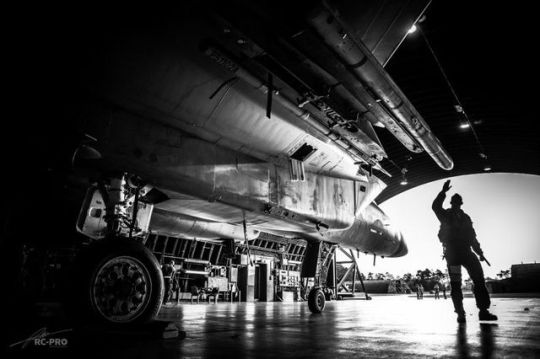
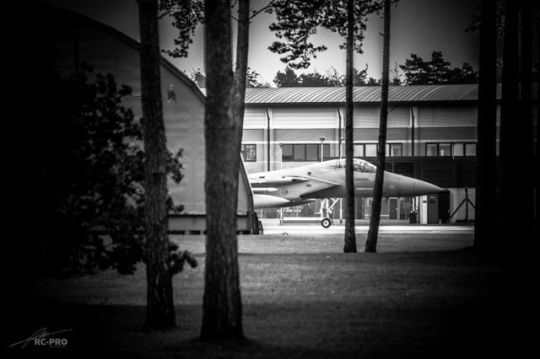
As intimidating as they come.
RAF Lakenheath - 493rd Fighter Squadron, "The Grim Reapers"
32 notes
·
View notes
Photo

In this image provided by the U.S. Air Force, a U.S. Air Force F-15C Eagle assigned to the 493rd Fighter Squadron, Royal Air Force (RAF) Lakenheath, takes off in support of North Atlantic Treaty Organization enhanced air policing missions with the Polish Air Force at Lask Air Base, Poland, Feb. 15, 2022. Russia's attack on Ukraine's Zaporizhzhia nuclear power plant has renewed calls for NATO to impose a no-fly zone over Ukraine, despite the repeated rejection of the idea by western leaders concerned about triggering a wider war in Europe. (Tech. Sgt. Jacob Albers/U.S. Air Force via AP) (في مصلحة سك العملة المصرية) https://www.instagram.com/p/Cas13UvMG3s/?utm_medium=tumblr
0 notes
Text

493rd Fighter Squadron, Grim Reapers at RAF Lakenheath, 2018
@SkytrailerCOM via X
10 notes
·
View notes
Video
"Reapers Return" by Chris
Via Flickr:
493rd Fs F-15's Return After Another Mission.
#USAF#USAF Lakenheath#United States Air Force#493rd Fighter Squadron#The Grim Reapers#F-15C#F-15d#Canon.#7D MK2
22 notes
·
View notes
Photo

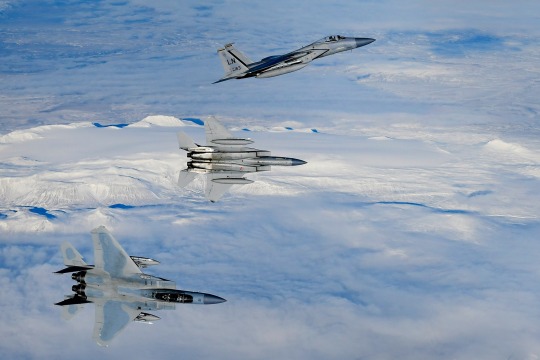
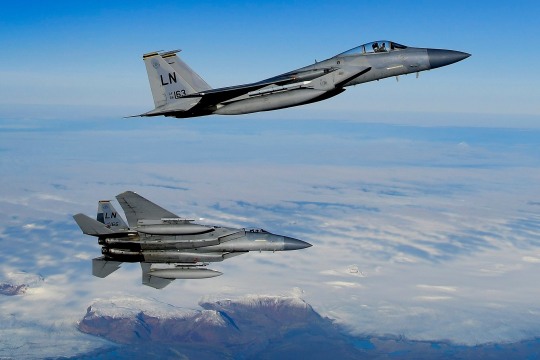
U.S. Air Force F-15C/D Eagles, assigned to the 493rd Expeditionary Fighter Squadron, conduct a routine aerial mission in support of NATO Air Police operations at Keflavik Air Base, Iceland, Oct. 20, 2020. Operations and exercises like the NATO Air Police mission, uphold international rule-based order, and maintain a steadfast layer of collective defense for all allied Arctic members. (U.S. Air Force photo/ Master Sgt. Matthew Plew)
100 notes
·
View notes
Photo
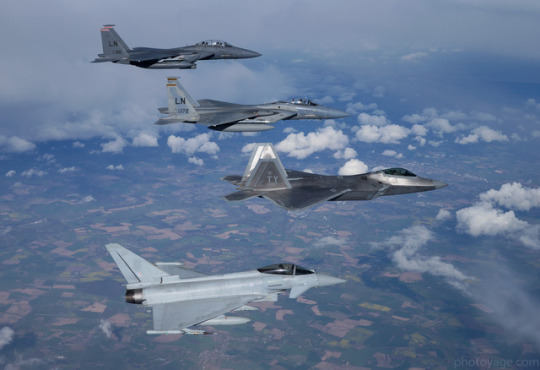
A four-ship formation consisting of a U.S. Air Force F-15E Strike Eagle from the 494th Fighter Squadron, an F-15 Eagle from the 493rd Fighter Squadron, an F-22A from the 95th Fighter Squadron, and a Royal Air Force Typhoon fly together during a training sortie April 26, 2016. 95th FS Airmen and aircraft are deployed from Tyndall Air Force Base, Fla., and will be conducting air training exercises with other U.S. and Royal Air Force aircraft over the next several weeks. (Courtesy photo by Jim Haseltine/Released)
95 notes
·
View notes
Text
US Air Force 48th Fighter Wing Agile Combat Employment’s Baltic Trident
Aircraft from the 492nd and 493rd Fighter Squadrons, and a small body of Airmen participated in exercise Baltic Trident at Ämari Air Base, Estonia, March 15-19, 2021. #military #defense #defence
Aircraft from the 492nd and 493rd Fighter Squadrons, and a small body of Airmen participated in exercise Baltic Trident at Ämari Air Base, Estonia, March 15-19, 2021. The exercise was centered on the Agile Combat Employment concept of operations, showcasing the 48th Fighter Wing’s multi-capable Airmen and their ability to work together with NATO allies and partner nations to effectively execute…
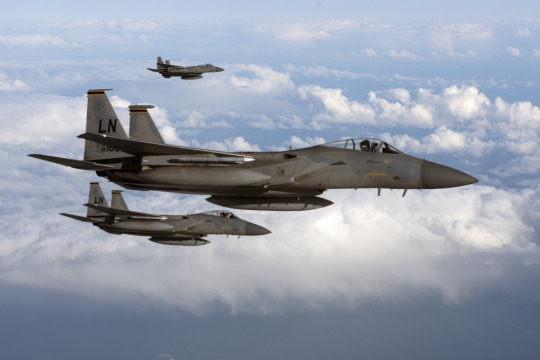
View On WordPress
0 notes
